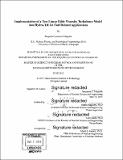| dc.contributor.advisor | Emilio Baglietto. | en_US |
| dc.contributor.author | Magolan, Benjamin Lawrence | en_US |
| dc.contributor.other | Massachusetts Institute of Technology. Department of Nuclear Science and Engineering. | en_US |
| dc.date.accessioned | 2016-07-18T20:02:39Z | |
| dc.date.available | 2016-07-18T20:02:39Z | |
| dc.date.copyright | 2015 | en_US |
| dc.date.issued | 2015 | en_US |
| dc.identifier.uri | http://hdl.handle.net/1721.1/103701 | |
| dc.description | Thesis: S.M., Massachusetts Institute of Technology, Department of Nuclear Science and Engineering, 2015. | en_US |
| dc.description | Cataloged from PDF version of thesis. | en_US |
| dc.description | Includes bibliographical references (pages 91-93). | en_US |
| dc.description.abstract | A quadratic [kappa]-[epsilon]non-linear eddy viscosity model (NLEVM) has been implemented into Hydra-TH, a Computational Fluid Dynamics (CFD) software being developed to support the nuclear reactor thermal-hydraulics modeling and simulation needs of the CASL program. This model adopts a non-linear extension of the stress-strain relationship that allows it to capture the anisotropy of flow conditions. Modeling this behavior is essential for the accurate simulation and prediction of the flow profile in fuel rod arrays, where secondary flow vortices arise and act to modify the flow profile. The quadratic model formulation in the greater context of Reynolds-Averaged Navier- Stokes (RANS) turbulence modeling is first presented. This is followed by a discussion of the key aspects of the standard and quadratic [kappa]-[epsilon] model implementations, which have been incorporated into the Hydra-TH source code to supplement the already fully-functioning RNG [kappa]-[epsilon] model. The three [kappa]-[epsilon] model variants are then applied to the 'classic' engineering test cases of flow in a square duct and a U-channel bend in order to highlight the relative merits and deficiencies of the quadratic model. Next, the quadratic model is validated on triangular and square rod fuel array test cases that are representative of the flow profile that develops in nuclear reactor subchannels. This thesis concludes with a rigorous sensitivity study of the triangular fuel rod array simulations, whereby guidelines and best practices for the quadratic model's use for nuclear fuel related applications are derived. | en_US |
| dc.description.statementofresponsibility | by Benjamin Lawrence Magolan. | en_US |
| dc.format.extent | 93 pages | en_US |
| dc.language.iso | eng | en_US |
| dc.publisher | Massachusetts Institute of Technology | en_US |
| dc.rights | M.I.T. theses are protected by copyright. They may be viewed from this source for any purpose, but reproduction or distribution in any format is prohibited without written permission. See provided URL for inquiries about permission. | en_US |
| dc.rights.uri | http://dspace.mit.edu/handle/1721.1/7582 | en_US |
| dc.subject | Nuclear Science and Engineering. | en_US |
| dc.title | Implementation of a non-linear eddy viscosity turbulence model into Hydra-TH for fuel related applications | en_US |
| dc.type | Thesis | en_US |
| dc.description.degree | S.M. | en_US |
| dc.contributor.department | Massachusetts Institute of Technology. Department of Nuclear Science and Engineering | |
| dc.identifier.oclc | 953203311 | en_US |
